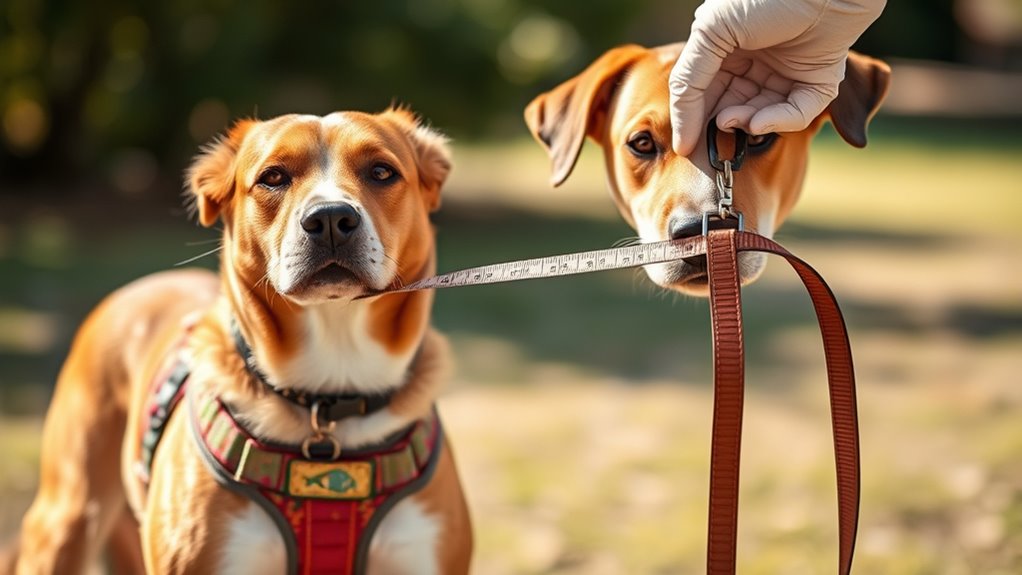To gauge leash training effectively, set clear goals like reducing pulling or improving recall, and track progress over time by noting walk duration, distance, and your dog’s body language. Observe signs of relaxation or tension and record any incidents like lunging or pulling. Use consistent reinforcement and note your dog’s focus during walks. Regularly evaluate responses across different environments and seek professional feedback to guarantee steady improvement — you’ll find more tips if you keep exploring.
Key Takeaways
- Establish clear, measurable training goals like loose leash walking and track progress regularly.
- Observe and interpret your dog’s body language to assess comfort and responsiveness during walks.
- Record walk durations, distances, and behavioral changes to monitor improvement over time.
- Use consistent reinforcement cues and focus indicators to evaluate training effectiveness.
- Document incidents, environmental factors, and professional feedback to refine techniques and track progress.
Establish Clear Training Goals

Before you begin leash training, it’s essential to set clear and specific goals. Know what you want to achieve, whether it’s loose-leash walking, recall, or basic obedience. Your training equipment should support these goals; for example, select a leash length that allows control but gives your dog room to explore comfortably. A shorter leash is ideal for beginners, providing better control, while a longer leash can help build confidence in open areas. Defining your goals helps you choose the right training equipment and guides your practice sessions. Clear objectives also keep you focused, ensuring consistency and progress. Setting realistic, measurable goals from the start makes it easier to track your dog’s development and adjust your methods accordingly. Additionally, understanding the signs of a checked-out partner can help you stay attentive to your dog’s emotional state and ensure a positive training experience.
Observe Your Dog’s Body Language and Behavior

Pay close attention to your dog’s body language and behavior during leash training, as these cues reveal how comfortable or stressed they are in different situations. Recognizing dog body language helps you modify your approach and ensures a positive experience. Look for leash tension cues like pulling or stiffening, which indicate discomfort or excitement. Watch for relaxed signs such as a wagging tail, soft eyes, and loose body posture. Conversely, signs of stress include pinned-back ears, lip licking, yawning, or tucked tail. Paying attention to these signals helps prevent escalation and builds trust. By understanding your dog’s non-verbal cues, you can better gauge their comfort level and adapt your training methods for a calmer, more enjoyable walk.
Track Walk Duration and Distance Progression

To effectively track your dog’s leash training progress, start by recording the walk duration and distance covered. Set small, achievable goals that gradually increase over time to build your dog’s confidence. Keeping detailed records helps you stay consistent and see tangible improvements as you advance. Additionally, using training logs can help you monitor patterns and adjust your training plan effectively.
Record Time and Length
Tracking the time and length of each walk helps you monitor your dog’s progress and adjust training accordingly. By recording how long and how far you go, you can identify patterns in your dog’s behavior, noting calming signals during walks, like yawning or sniffing. Use consistent leash attachments to maintain control and observe how your dog responds over time. Documenting these details allows you to see gradual improvements or setbacks. Consider these points:
- Note walk duration daily to spot consistency
- Record distances to measure stamina growth
- Observe calming signals for stress cues
- Adjust leash attachments for better control
- Track progress over weeks for long-term insights
- Pay attention to air quality during walks, as it can influence your dog’s comfort and stress levels.
This detailed record helps you to tailor your leash training, ensuring your dog becomes calm and confident on walks.
Set Incremental Goals
Building on your record-keeping, setting incremental goals for walk duration and distance helps you measure progress effectively. By establishing small, achievable targets, you can set realistic expectations and gradually increase training pace. This approach prevents frustration and promotes confidence in your dog’s leash skills. Use the table below to plan your progress:
| Week | Walk Duration | Distance | Notes |
|---|---|---|---|
| 1 | 10 minutes | 1 mile | Focus on loose leash |
| 2 | 15 minutes | 1.5 miles | Slightly increase pace |
| 3 | 20 minutes | 2 miles | Monitor dog’s comfort |
| 4 | 25 minutes | 2.5 miles | Adjust based on progress |
| 5 | 30 minutes | 3 miles | Celebrate milestones |
These goals help you track improvement while keeping expectations realistic. Additionally, implementing performance tracking can provide valuable insights into your leash training journey.
Use Positive Reinforcement Indicators
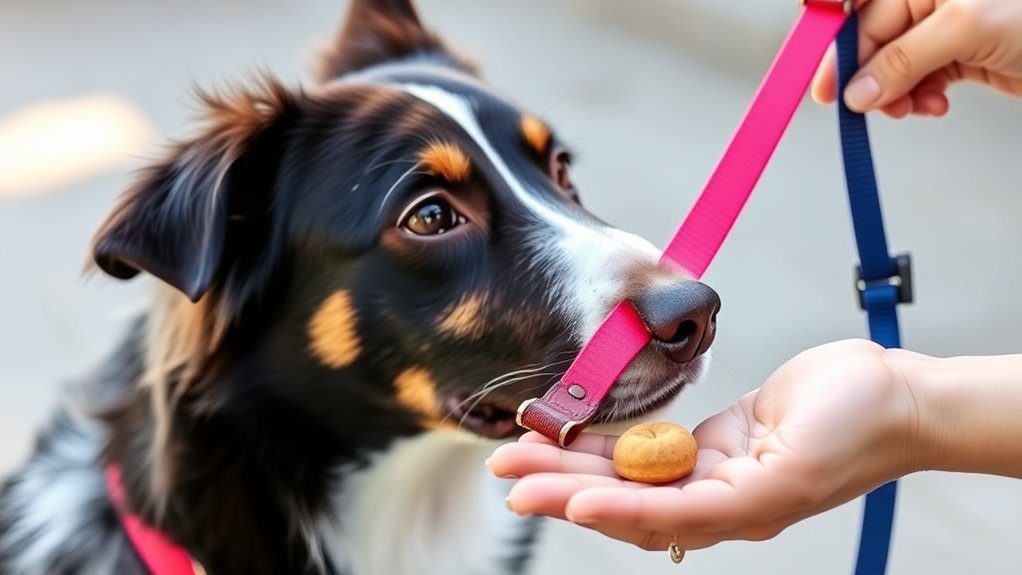
To effectively measure your dog’s progress, you need to recognize reward cues and use consistent markers. By tracking behavioral changes, you’ll see how well your training is working. These positive reinforcement indicators help you stay focused and adjust your approach as needed. Incorporating professional training techniques can further enhance your results.
Recognize Reward Cues
Recognizing reward cues is essential for effective leash training because it helps you identify when your dog is motivated and responds well to positive reinforcement. By paying attention to subtle signals, you can reinforce good behavior at the right moment, especially during clicker training. Proper treat timing ensures your dog associates the cue with the reward. Look for these cues:
- Enthusiastically watching or leaning toward you
- Excited tail wagging
- Relaxed body language
- Quiet, focused attention
- Lightly pawing or nudging
These signs indicate your dog is receptive to reinforcement. When you see these cues, use a clicker or verbal marker to pinpoint the behavior, then give a treat. Recognizing reward cues ensures your training is timely and effective, strengthening your bond. Additionally, understanding the importance of positive reinforcement in training can lead to faster learning and a happier, more obedient dog.
Use Consistent Markers
Using consistent markers helps guarantee your dog clearly understands when they’ve done something right. In clicker training, a distinct sound signals success, making it easier for your dog to connect the behavior with the reward. When applying leash tension, use the same marker each time your dog responds correctly, such as a verbal cue or a clicker sound. This consistency helps your dog recognize the precise moment they’ve met your expectations. Avoid mixing markers or changing your signals mid-training, as this can create confusion. Instead, stick to one positive reinforcement indicator to reinforce good behavior reliably. Over time, your dog will associate the marker with the reward, improving their understanding and responsiveness. Consistent markers are essential for clear communication during leash training, leading to faster progress. Additionally, understanding how fandom’s communication patterns develop can inform how you structure training sessions for better engagement.
Track Behavioral Changes
Tracking your dog’s behavioral changes is essential for evaluating progress during leash training. By observing how your dog responds over time, you can identify key training milestones and maintain behavioral consistency. Positive reinforcement indicators, like a wagging tail or relaxed breathing, signal your dog’s comfort and progress. To effectively monitor these changes, look for:
- Increased calmness on walks
- Reduced pulling or lunging
- Consistent responses to commands
- Fewer distractions or reactive behaviors
- Overall confidence and enjoyment during walks
Noticing these signs helps you adjust your training approach and celebrate milestones. Regularly tracking behavioral changes ensures your training remains focused and effective, leading to a well-behaved, happy leash partner. Additionally, paying attention to signs of comfort and safety during walks can prevent potential hazards and ensure a positive experience for both you and your dog.
Record Incidents of Pulling or Lunging
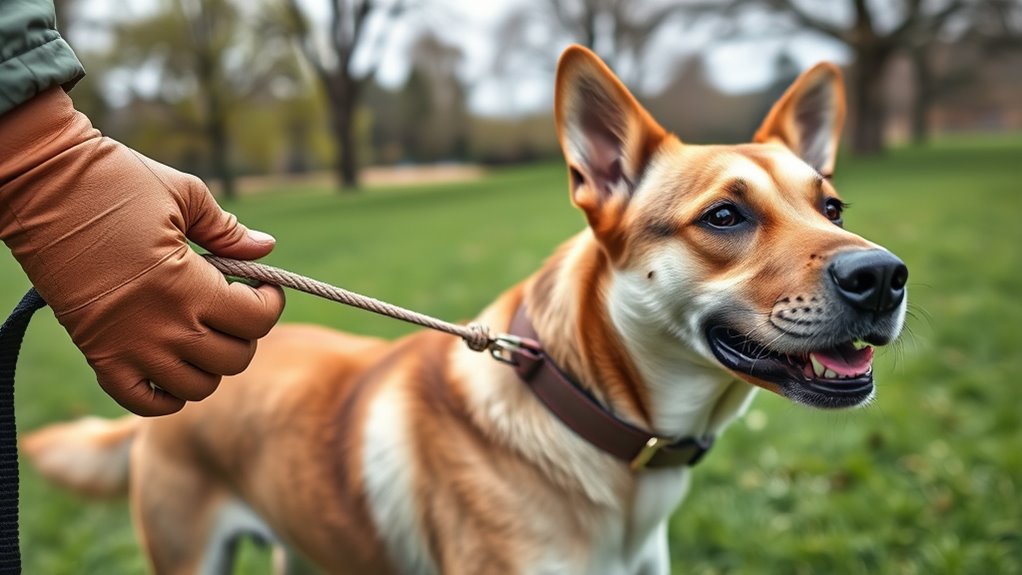
Keeping a detailed record of each incident when your dog pulls or lunges on the leash is essential for monitoring progress and identifying patterns. Note the circumstances, such as the location, other dogs, or distractions present. Track how often these incidents happen and whether they increase or decrease over time. Using specific leash accessories like harnesses or head collars can help reduce pulling, so observe their effects too. If your dog reacts strongly during walks, recording these episodes helps you see what triggers the behavior. This information guides your training plan and helps you know if your methods are working. Consistent documentation makes it easier to adjust your approach and celebrate small victories, keeping you motivated to stick with leash training. Incorporating data-driven strategies can further optimize your training by highlighting what techniques are most effective.
Assess Your Dog’s Focus and Attention During Walks
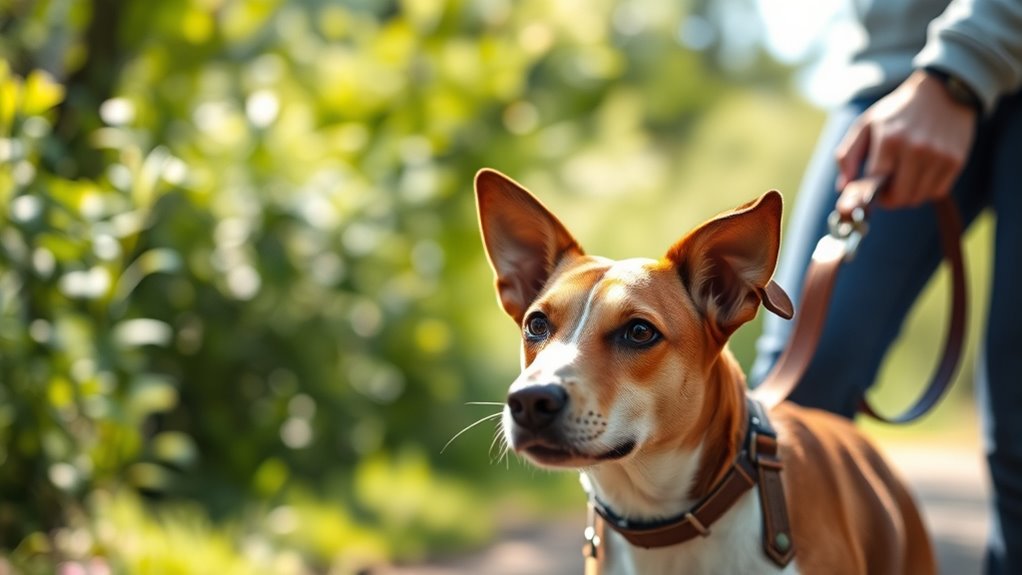
How focused is your dog during walks? Evaluating their dog focus and attention helps determine if they’re learning leash training effectively. Watch for signs like their ability to stay calm, maintain eye contact, and respond to your cues. Notice how the leash tension varies as they pay attention or get distracted. Incorporating essential oils for calming can sometimes help create a more relaxed environment, making training sessions more effective. You might see: – The dog walking steadily without pulling, maintaining consistent leash tension – Brief moments where they look around but quickly return focus – The dog responding promptly to your commands – Minimal tugging when they’re engaged – Distractions causing a spike in leash tension, but quickly calming down These indicators help you gauge how well your dog is staying attentive during walks, which is key to improving leash training success.
Monitor Reaction to Distractions and Other Dogs
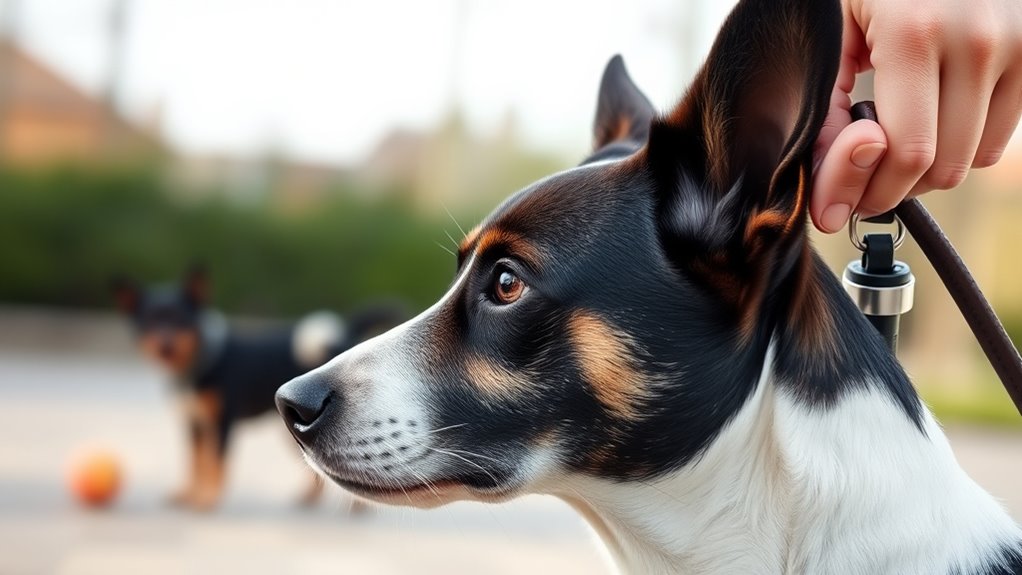
Pay close attention to how your dog reacts when they encounter distractions or other dogs during walks. Monitoring their reactions helps you gauge their progress with distraction management and dog socialization. Notice if they remain calm, pull on the leash, bark, or become overly distracted. These responses indicate areas where training may need reinforcement. If your dog stays focused and responds to commands despite nearby distractions, you’re on the right track. Conversely, if they become overwhelmed or reactive, it’s a sign to pause and work on gradual exposure in controlled settings. Tracking these reactions allows you to adapt your training approach, ensuring your dog learns to stay composed in various situations. Consistent observation helps you measure growth and develop effective distraction management strategies. Using proper storage techniques for treats and training tools can also support your training consistency and success.
Evaluate Consistency Across Different Environments
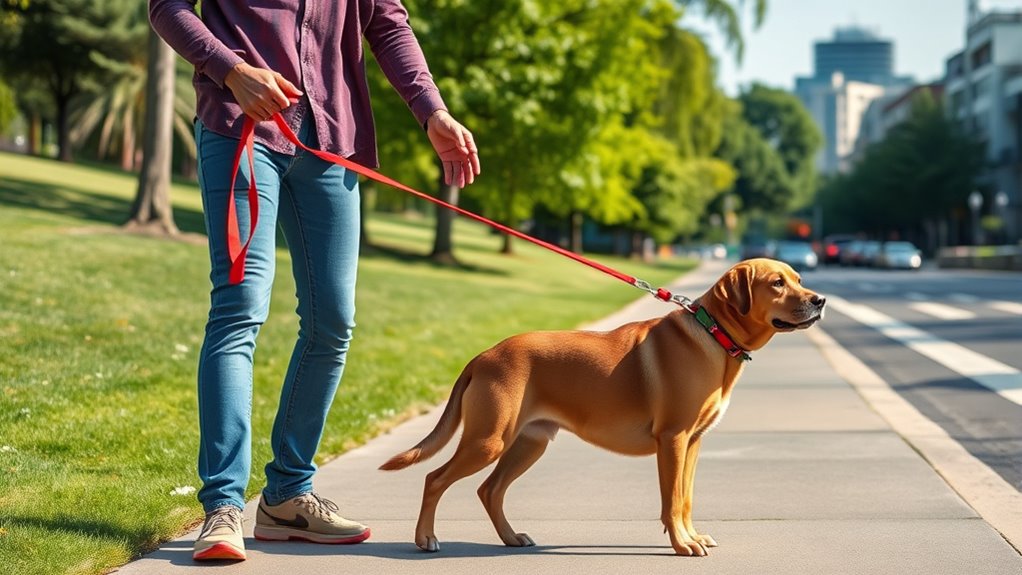
To guarantee your dog’s leash training is effective, it’s important to evaluate how consistently they respond across different environments. Changes in surroundings can influence your dog’s behavior, so observe how they handle various settings. Use consistent training equipment and keep the leash length appropriate for each environment, whether it’s a quiet park or a busy street. Be mindful of your dog’s reactions and adjust as needed to maintain control.
- Test in quiet, familiar areas and crowded places
- Check if your dog maintains focus with different distractions
- Observe their reaction to new sights and sounds
- Ensure the leash length allows safe exploration without pulling
- Confirm they respond reliably despite environmental changes
Seek Feedback From a Professional Trainer
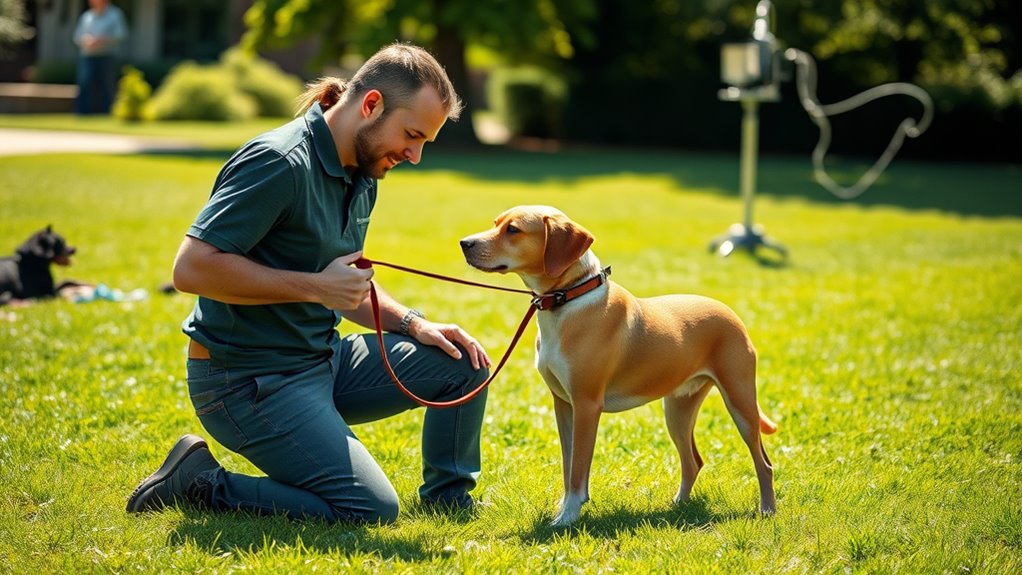
Seeking feedback from a professional trainer can provide valuable insights into your dog’s leash manners and training progress. A skilled trainer evaluates your current training techniques and identifies areas for improvement. They can observe how your dog responds to commands, leash handling, and whether your training methods are effective. When choosing a trainer, check their credentials and experience to guarantee they’re qualified to guide you properly. Their expertise helps you understand if you’re on the right track or need to adjust your approach. Regular feedback from a professional also boosts your confidence, ensuring you’re applying the best techniques for your dog’s success. Additionally, understanding the value of home security systems underscores the importance of professional guidance in achieving your training goals. Ultimately, their guidance helps you measure progress accurately and develop a more effective leash training routine.
Frequently Asked Questions
How Can I Tell if My Dog Is Truly Ready to Progress in Leash Training?
You’ll know your dog is ready to progress in leash training when they display patience during walks and maintain focus despite distractions. If your dog stays calm, responds reliably to commands, and doesn’t pull or get easily frustrated, it’s a sign they’re ready for the next step. Consistent leash progress shows they’re comfortable, confident, and ready to handle more challenging situations, making training more effective and enjoyable for both of you.
What Are Common Signs of Frustration or Fatigue During Leash Training Sessions?
You might notice signs of frustration or fatigue during leash training if your dog tugs excessively, yanks on the leash, or repeatedly pulls away. Watch for body language cues like yawning, lip licking, or avoiding eye contact. Environmental distractions can heighten these signs, making your dog more restless or anxious. If these behaviors persist, give your dog a break and gradually reintroduce training to prevent burnout and build positive associations.
How Do I Adjust Training Methods for Different Dog Breeds or Sizes?
Think of tailoring your approach like fitting a custom suit. For breed-specific adjustments, consider your dog’s energy level and temperament, while size-based modifications focus on leash length and control. Smaller breeds may need gentler guidance, whereas larger dogs require stronger, more consistent commands. You adapt your techniques to match your dog’s unique traits, ensuring training remains effective and comfortable, transforming the leash into a tool of connection rather than frustration.
What Tools or Equipment Best Support Accurate Measurement of Training Progress?
You should use a training log and progress charts to accurately measure your leash training progress. Keep detailed notes on each session, noting behaviors, duration, and issues. Progress charts help visualize improvements over time, making it easier to identify trends and adjust your approach. Consistently recording data guarantees you stay on track and recognize milestones, ultimately leading to more effective training results for your dog.
How Often Should I Revisit and Reassess My Leash Training Goals?
You should revisit and reassess your leash training goals every few weeks. This allows you to track progress and adjust training milestones as needed. Regular check-ins help you identify areas where your dog may need extra support, ensuring steady improvement. By consistently monitoring progress tracking, you stay motivated and can celebrate successes, making training more effective and enjoyable for both you and your dog.
Conclusion
By carefully tracking every step, pull, and glance, you’ll transform your walks from chaotic storms into smooth sailing. Imagine your dog finally walking like a perfectly trained superstar, confidently strutting past distractions as if the world isn’t even there. With consistency and patience, you’ll turn every leash session into a masterpiece of harmony—more breathtaking than a sunset, more unstoppable than a tidal wave. Keep measuring, adjusting, and celebrating—you’re on your way to leash training greatness!
